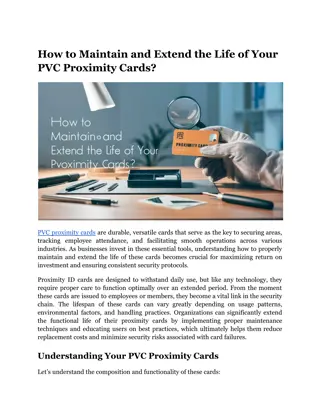
Advantages of Using PVC Proximity Cards Over Other Materials
Discover the top benefits of PVC proximity cards and why they offer superior durability, flexibility, and security.
Download Presentation

Please find below an Image/Link to download the presentation.
The content on the website is provided AS IS for your information and personal use only. It may not be sold, licensed, or shared on other websites without obtaining consent from the author. If you encounter any issues during the download, it is possible that the publisher has removed the file from their server.
You are allowed to download the files provided on this website for personal or commercial use, subject to the condition that they are used lawfully. All files are the property of their respective owners.
The content on the website is provided AS IS for your information and personal use only. It may not be sold, licensed, or shared on other websites without obtaining consent from the author.
E N D
Presentation Transcript
Advantages of Using PVC Proximity Cards Over Other Materials The choice of materials for identification cards plays a paramount role in determining the efficiency, durability, and overall effectiveness of these systems. For example, PVC (Polyvinyl Chloride) has emerged as a frontrunner, particularly in the realm of proximity cards. These unassuming pieces of plastic have revolutionized how we approach security, offering a perfect cost-effectiveness. blend of functionality, durability, and The rise of PVC proximity cards to prominence isn't merely a coincidence. It's the result of years of research, technological advancements, and a deep understanding of the needs of both security professionals and end-users. From bustling corporate offices to high-security government facilities, from state-of-the-art healthcare institutions, they have found their place as the go-to choice for access control solutions. sprawling university campuses to But what makes PVC stand out in a field where alternatives like metal, paper, or even more exotic materials exist? Why have proximity card vendors increasingly turned to PVC as their material of choice? And most importantly, how do these cards offer advantages that translate into tangible benefits for organizations of all sizes?
The Fundamentals of PVC Proximity Cards They are a type of contactless smart card that uses radio-frequency identification (RFID) technology to communicate with card readers. It typically operates at a frequency of 125 kHz, which is why it is often referred to as a 125kHz proximity card. Key components of a PVC proximity card include: A PVC outer layer An embedded antenna A microchip storing unique identification data Bristol ID Technologies, a leader in the field, offers a range of PVC proximity cards designed to meet diverse security needs across various industries. Read More Article: The Importance of Backup Systems in Proximity Card Access Control Physical Advantages of PVC Proximity Cards PVC as a material offers several physical advantages that make it ideal for proximity cards: Durability: PVC cards are resistant to: Bending and flexing Moisture and humidity Moderate temperature fluctuations Printability: PVC provides an excellent surface for: High-quality color printing Photo ID integration Holographic overlays for added security Customizability: PVC cards can be easily: Cut into various shapes and sizes Embossed or debossed Fitted with additional features like magnetic stripes The durability of PVC cards translates to a longer lifespan, reducing the frequency of replacements and lowering long-term costs for organizations.
Technological Compatibility One of the standout features of an ISO PVC proximity card is its wide-ranging compatibility with various access control systems. This compatibility stems from: Standardized dimensions (CR80 size) Consistent placement of RFID components Adherence to ISO/IEC standards This standardization ensures that these cards can be used across different: Card readers Access control software Security management systems The versatility of PVC cards makes them an ideal choice for organizations looking to implement or upgrade their access control systems without overhauling their entire infrastructure. Cost-Effectiveness When it comes to balancing quality and affordability, they stand out: Lower production costs compared to metal or composite materials Bulk manufacturing capabilities reduce per-unit costs Long lifespan minimizes replacement expenses For organizations of all sizes, their cost-effectiveness translates to: More manageable upfront investments Reduced long-term operational costs Better allocation of security budgets Enhanced Security Features Proximity ID cards made from PVC offer a robust platform for implementing advanced security features: Visual Security Elements: High-resolution printing for intricate designs UV-reactive inks for covert security
Micro-text and guilloch patterns Physical Security Features: Holographic overlays Embedded security threads Tamper-evident materials Digital Security Capabilities: Encrypted RFID communication Unique identification numbers Integration with biometric data These multi-layered security features make them extremely difficult to counterfeit or tamper with, enhancing the overall security posture of organizations that use them. Environmental Considerations While PVC has faced scrutiny for its environmental impact, modern manufacturing processes have significantly improved its eco-friendliness: Recyclable PVC formulations Energy-efficient production methods A longer lifespan reduces waste Many organizations environmental footprint. proximity card maintain vendors now offer eco-friendly PVC options, allowing standards while to high-security minimizing their Versatility in Application They shine in their ability to serve multiple purposes: Access Control: Primary function for secure entry Time and Attendance: Tracking employee work hours Cashless Payments: Integration with cafeteria or vending systems Library Services: Book checkouts and resource access Parking Management: Automated vehicle access This multi-functionality allows organizations to streamline their operations, using a single card for various applications and reducing the need for multiple credentials.
The Rise of Hybrid Cards The flexibility of PVC has paved the way for hybrid cards, combining proximity technology with other features: Proximity smart card for integrating high-frequency smart chip technology Dual-frequency cards for legacy system compatibility Combination of contact and contactless technologies These hybrid solutions offer: Seamless transitions between different security protocols Future-proofing against technological advancements Enhanced functionality without compromising on the benefits of PVC User Experience and Acceptance The success of any access control system heavily relies on user adoption and satisfaction. PVC proximity cards excel in this area due to: Lightweight and comfortable to carry Familiar form factor (similar to credit cards) Quick and intuitive use These factors contribute to: Higher compliance rates with security protocols Reduced resistance to new system implementations Improved overall security culture within organizations Comparison with Alternative Materials To fully appreciate the advantages of PVC, let's briefly compare it with alternative materials: 1. Metal Cards: Pros: Durability, premium feel Cons: Higher cost, potential interference with RFID signals 2. Paper Cards:
Pros: Low cost, eco-friendly Cons: Poor durability, limited security features 3. Composite Materials: Pros: Enhanced durability, premium options Cons: Higher costs, limited availability In most scenarios, PVC strikes the optimal balance between cost, durability, and functionality, making it the preferred choice for proximity ID cards. Read More Article: Exploring the Use of Proximity Cards for Visitor Management Implementation Considerations When considering the implementation of these cards, organizations should keep in mind: Compatibility with existing infrastructure Scalability for future expansion Integration with other security systems (e.g., video surveillance) Working with an experienced company can help in navigating these considerations and designing a system that maximizes the benefits of PVC cards. Future Trends and Innovations The world of PVC proximity cards continues to evolve. Emerging trends include: Integration with mobile credentials Enhanced data storage capabilities Advancements in eco-friendly PVC formulations These innovations promise to further cement the position of PVC as the material of choice for proximity cards in the foreseeable future. Conclusion
With a focus on both security and user experience, the choice of PVC for proximity cards emerges not just as a practical decision, but as a strategic investment in a comprehensive and adaptable security infrastructure. Its advantages extend far beyond its physical properties, encompassing technological compatibility, cost-effectiveness, and environmental considerations. Choose Bristol ID Technologies for remarkable expertise, exceptional customer service, and state-of-the-art identification products that drive your security forward. With a commitment to quality and security, we provide a tailored proximity smart card for every industry, from corporate enterprises to healthcare facilities. Our expert team works closely with clients to ensure seamless integration and optimal functionality. Site Article: Advantages of Using PVC Proximity Cards Over Other Materials






















